What Determines the Direction of Microsaccades?
Abstract
:Introduction
Microsaccades and attention
Microsaccade direction
Attentional cueing in multiple directions
Methods
Participants
Apparatus
Stimuli
Design
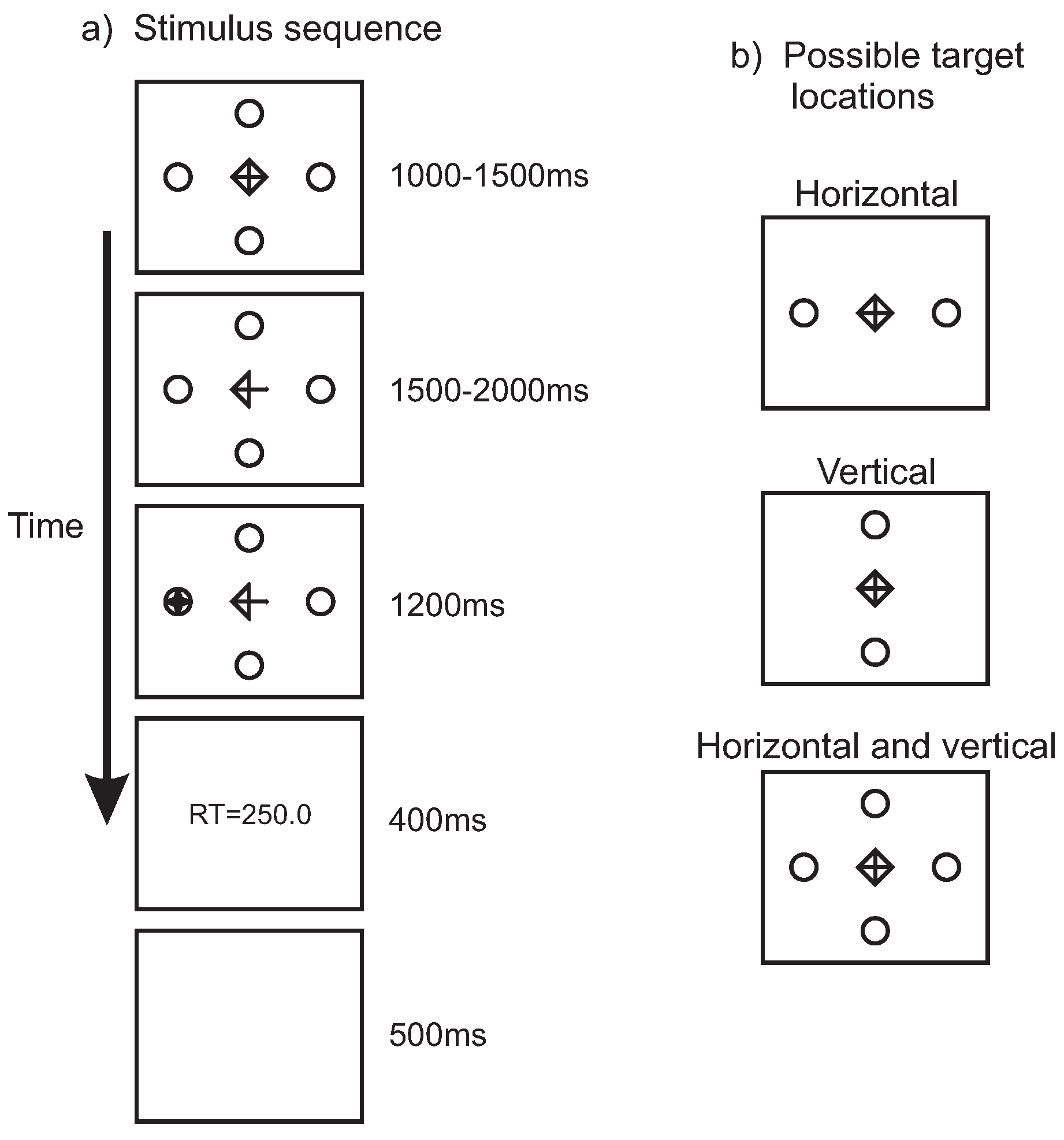
Procedure
Data analysis
Results
Response times
Microsaccade frequency

| Su | BinH | BinV | BinHV | MonHL | MonVL | MonHVL | MonHR | MonVR | MonHVR |
| 1 | 1.22 | 1.45 | 1.40 | 0.40 | 0.37 | 0.46 | 1.00 | 1.29 | 1.32 |
| 2 | 1.45 | 1.71 | 1.45 | 0.60 | 0.73 | 0.72 | 0.66 | 0.64 | 0.84 |
| 3 | 1.02 | 1.12 | 1.39 | 0.76 | 0.76 | 1.03 | 1.22 | 1.52 | 1.24 |
| 4 | 0.30 | 0.27 | 0.25 | 0.47 | 0.46 | 0.37 | 0.68 | 0.81 | 0.57 |
| 5 | 1.82 | 1.81 | 1.56 | 1.03 | 1.06 | 0.90 | 0.56 | 0.68 | 0.65 |
| 6 | 0.44 | 0.74 | 0.72 | 0.59 | 0.42 | 0.51 | 0.42 | 0.34 | 0.50 |
| 7 | 0.28 | 0.50 | 0.32 | 0.18 | 0.46 | 0.46 | 0.23 | 0.39 | 0.22 |
| 8 | 0.89 | 0.94 | 0.81 | 0.30 | 0.25 | 0.19 | 0.60 | 0.64 | 0.52 |
| Mean | 0.93 | 1.07 | 0.99 | 0.54 | 0.56 | 0.58 | 0.67 | 0.79 | 0.73 |
Microsaccade direction
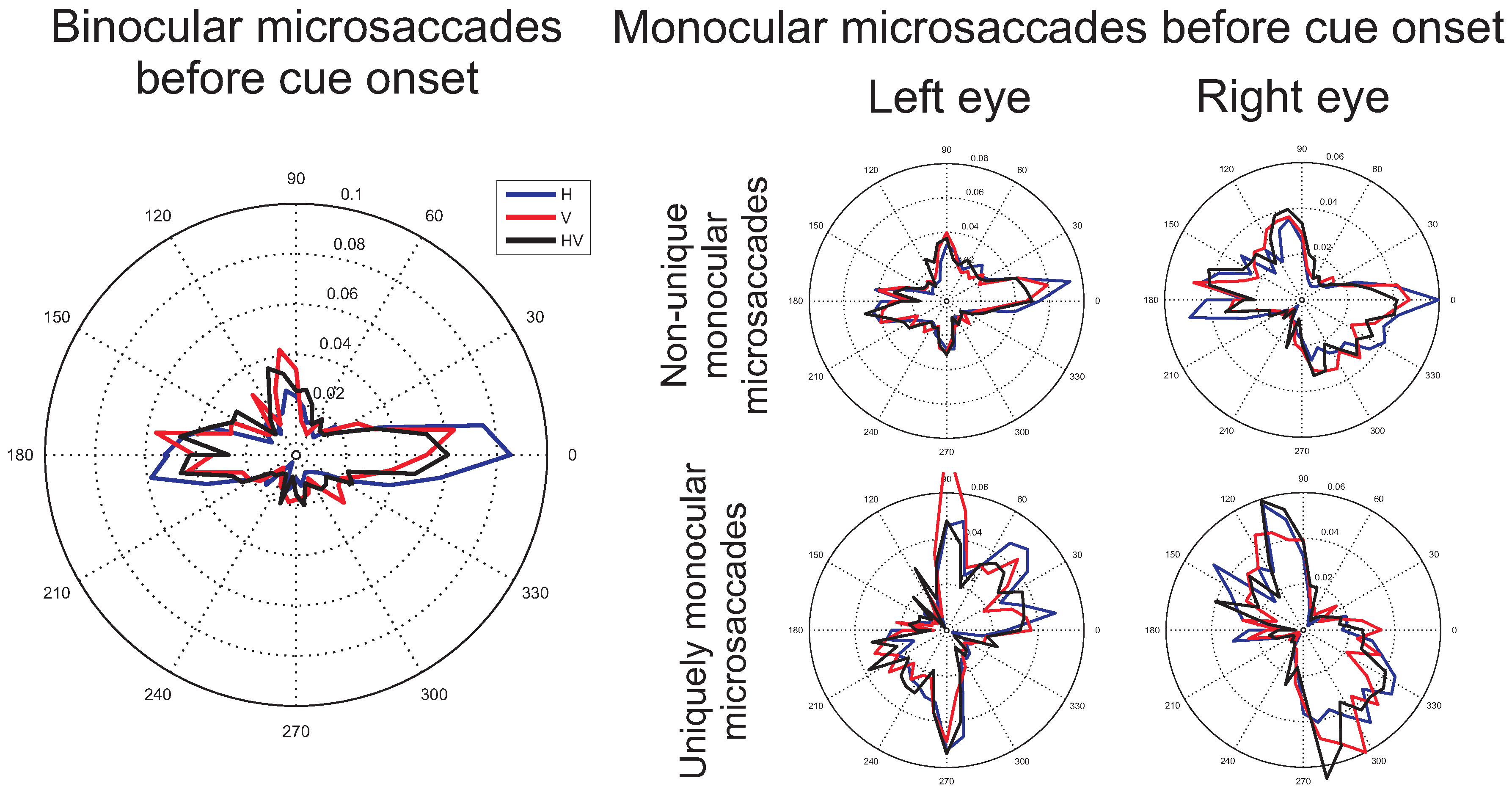
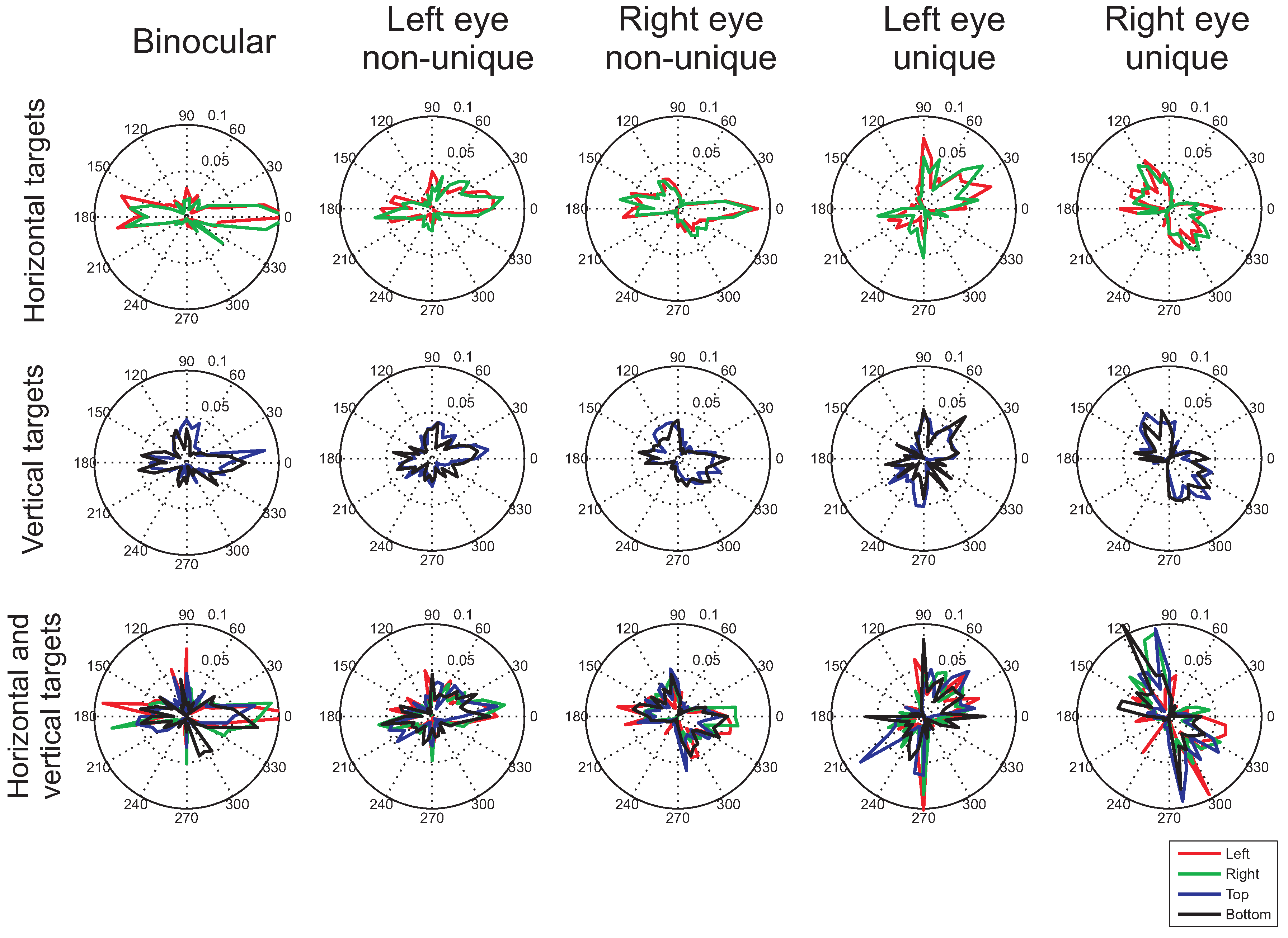
Time-course of microsaccade bias
Microsaccade amplitude
Monocular and binocular microsaccades

Discussion
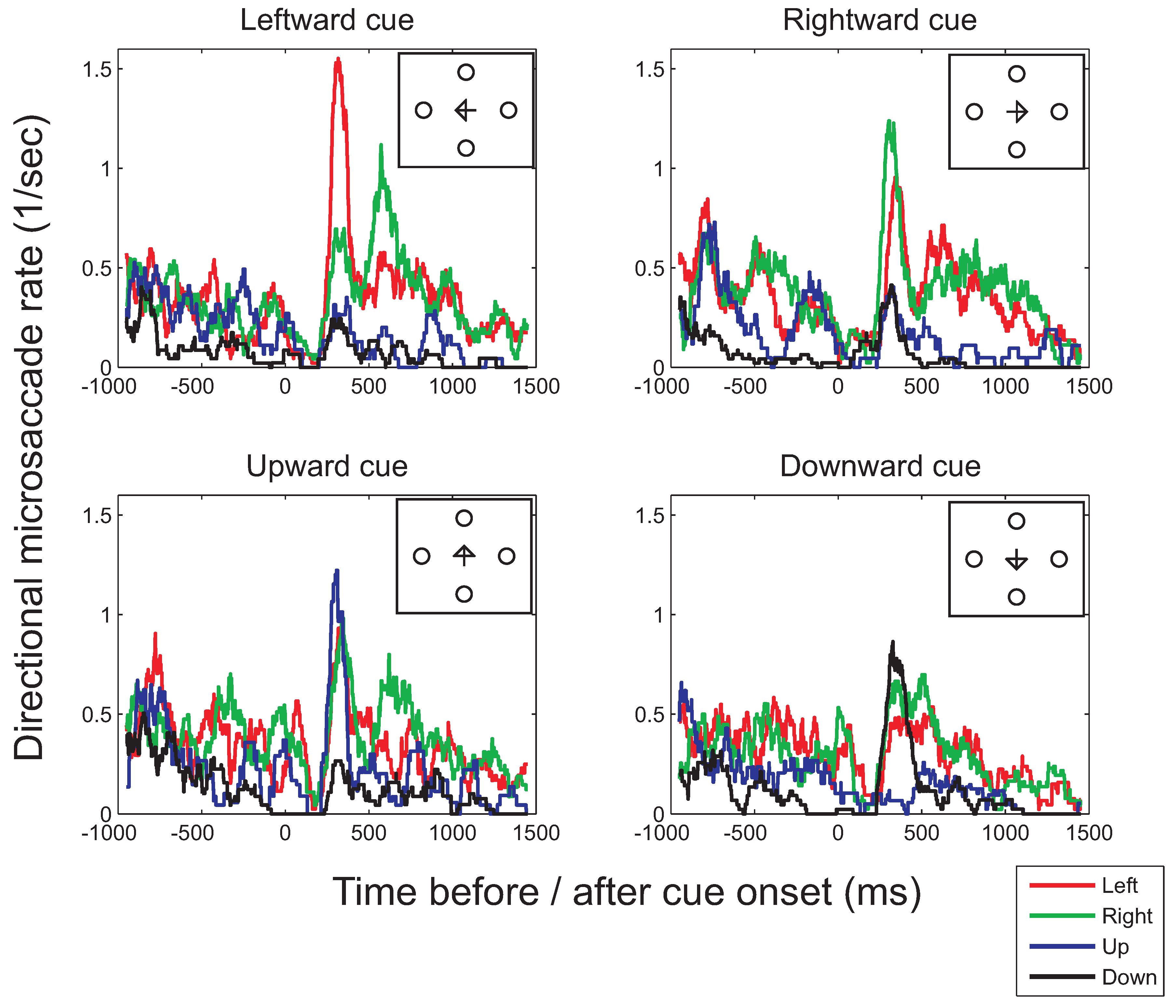
Response times
Microsaccade frequency
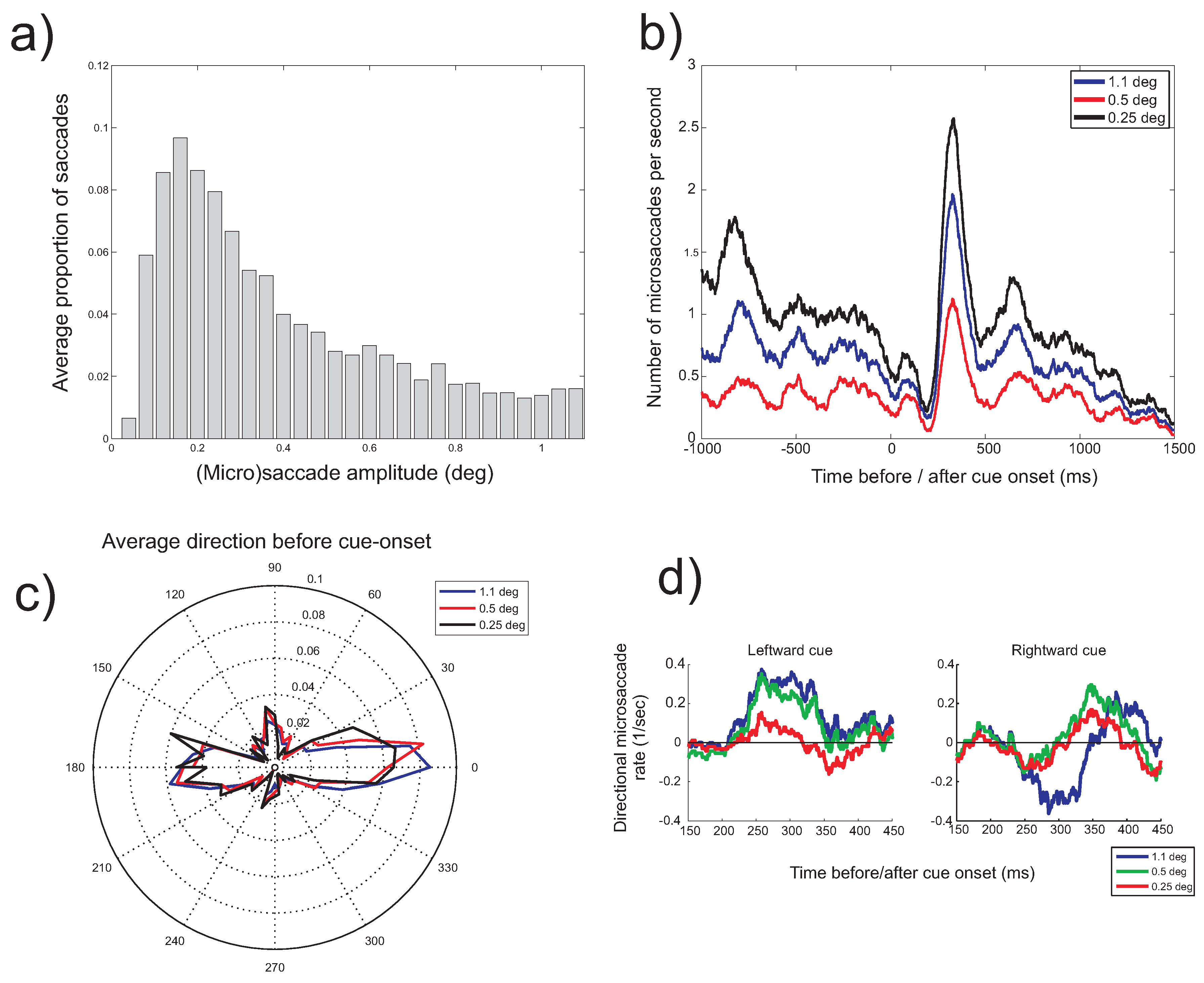
Microsaccade direction: attention
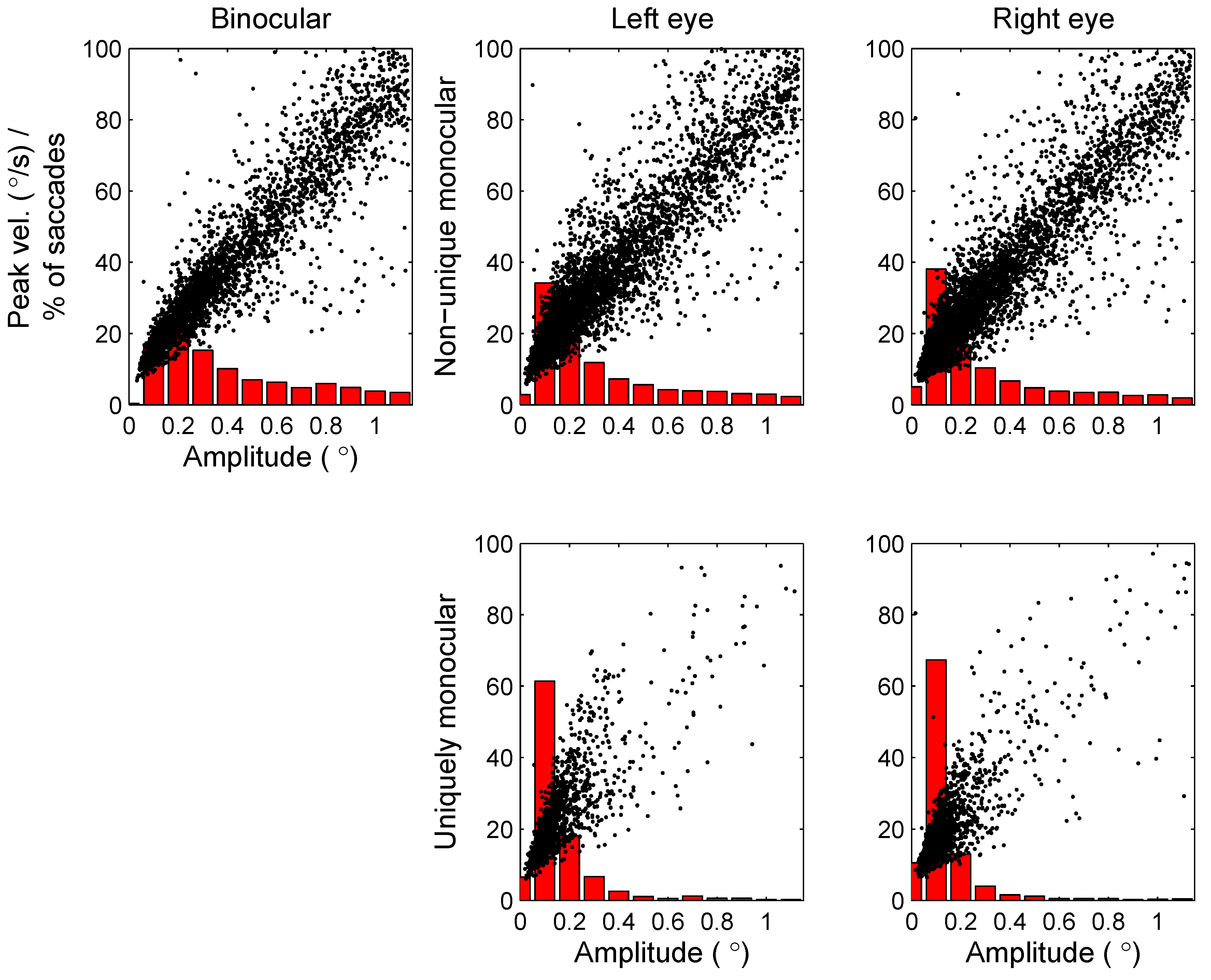
Microsaccade direction: Possible target locations

Microsaccade direction: Monocular and binocular microsaccades
Other factors that could determine microsaccade direction
Conclusion
Funding
References
- Abadi, R. V., and E. Gowen. 2004. Characteristics of saccadic intrusions. Vision Research 44: 2675–2690. [Google Scholar]
- Betta, E., G. Galfano, and M. Turatto. 2007. Microsaccadic response during inhibition of return in a targettarget paradigm. Vision Research 47, 3: 428–436. [Google Scholar] [PubMed]
- Betta, E., and M. Turatto. 2006. Are you ready? I can tell by looking at your microsaccades. Neuroreport (17): 1001–1004. [Google Scholar] [PubMed]
- Collewijn, H., and E. Kowler. 2008. The significance of microsaccades for vision and oculomotor control. Journal of Vision 8: 1–21. [Google Scholar]
- Deaner, R. O., and M. L. Platt. 2003. Reflexive social attention in monkeys and humans. Current Biology 13: 1609–1613. [Google Scholar] [CrossRef]
- Engbert, R. 2006. Microsaccades: A microcosm for research on oculomotor control, attention, and visual perception. Progress in Brain Research 154: 177–192. [Google Scholar]
- Engbert, R., and R. Kliegl. 2003a. Microsaccades uncover the orientation of covert attention. Vision Research 43, 9: 1035–1045. [Google Scholar]
- Engbert, R., and R. Kliegl. 2003b. Binocular coordination in microsaccades. In The mind’s eyes: Cognitive and applied aspects of eye movements. Edited by J. Hyona, R. Radach and H. Deubel. Oxford: Elsevier, pp. 103–117. [Google Scholar]
- Engbert, R., and K. Mergenthaler. 2006. Microsaccades are triggered by low retinal image slip. Procedings of the National Academy of Sciences U.S.A. 103: 7192–7197. [Google Scholar]
- Findlay, J. M. 1974a. A simple apparatus for recording microsaccades during visual fixation. Quarterly Journal of Experimental Psychology 26: 167–170. [Google Scholar]
- Findlay, J. M. 1974b. Direction perception and human fixation eye movements. Vision Research 14: 703–711. [Google Scholar]
- Findlay, J. M. 2003. Eye movements and visual information processing. In The mind’s eyes: Cognitive and applied aspects of eye movements. Edited by J. Hyona, R. Radach and H. Deubel. Oxford: Elsevier, pp. 143–155. [Google Scholar]
- Galfano, G., E. Betta, and M. Turatto. 2004. Inhibition of return in microsaccades. Experimental Brain Research 159, 3: 400–404. [Google Scholar] [CrossRef]
- Gottlob, L. R. 2004. Location cuing and response time distributions in visual attention. Perception & Psychophysics 66: 1293–1302. [Google Scholar]
- Gowen, E., R. V. Abadi, E. Poliakoff, P. C. Hansen, and R. C. Miall. 2007. Modulation of saccadic intrusions by exogenous and endogenous attention. Brain Research 1141: 154–167. [Google Scholar] [PubMed]
- Hafed, Z. M., and J. J. Clark. 2002. Microsaccades as an overt measure of covert attention shifts. Vision Research 42: 2533–2545. [Google Scholar] [CrossRef] [PubMed]
- Hafed, Z. M., L. Goffart, and R. J. Krauzlis. 2009. A neural mechanism for microsaccade generation in the primate superior colliculus. Science 323: 940–943. [Google Scholar] [CrossRef]
- Hansen, B. C., and E. A. Essock. 2004. A horizontal bias in human visual processing of orientation and its correspondence to the structural components of natural scenes. Journal of Vision 4, 12:5: 1044–1060. [Google Scholar]
- Hermens, F., and R. Walker. in press. Gaze and arrow distractors influence saccade trajectories similarly. In Quarterly Journal of Experimental Psychology. [Google Scholar]
- Hermens, F., J. M. Zanker, and R. Walker. 2010. Microsaccades and preparatory set: A comparison between delayed and immediate, exogenous and endogenous proand anti-saccades. Experimental Brain Research 201, 3: 489–498. [Google Scholar]
- Horowitz, T. S., E. M. Fine, D. E. Fencsik, S. Yurgenson, and J. M. Wolfe. 2007. Fixational eye movements are not an index of covert attention. Psychological Science 18: 356–363. [Google Scholar]
- Horwitz, G. D., and T. D. Albright. 2003. Short-latency fixational saccades induced by luminance increments. Journal of Neurophysiology 90: 1333–1339. [Google Scholar]
- Kloke, W. B., W. Jaschinski, and S. Jainta. 2009. Microsaccades under monocular viewing conditions. Journal of Eye Movement Research 3, 1: 1–7. [Google Scholar]
- Kowler, E. 1990. The role of visual and cognitive processes in the control of eye movement. In Eye movements and their role in visual and cognitive processes. Edited by E. Kowler. Amsterdam: Elsevier. [Google Scholar]
- Kowler, E., and R. M. Steinman. 1980. Small saccades serve no useful purpose: reply to a letter by R. W. Ditchburn. Vision Research 20: 273–276. [Google Scholar]
- Krauskopf, J., T. N. Cornsweet, and L. A. Riggs. 1960. Analysis of eye movements during monocular and binocular fixation. Journal of the Optical Society of America 50: 572–578. [Google Scholar] [PubMed]
- Kuhn, G., and V. Benson. 2007. The influence of eye-gaze and arrow pointing distractor cues on voluntary eye movements. Perception & Psychophysics 69: 966–971. [Google Scholar]
- Laubrock, J., R. Engbert, and R. Kliegl. 2005. Microsaccade dynamics during covert attention. Vision Research 45, 6: 721–730. [Google Scholar] [PubMed]
- Laubrock, J., R. Engbert, M. Rolfs, and R. Kliegl. 2007. Microsaccades are an index of covert attention: commentary on Horowitz, Fine, Fencsik, Yurgenson, and Wolfe (2007). Psychological Science 18, 4: 364–366. [Google Scholar]
- Laubrock, J., R. Kliegl, M. Rolfs, and R. Engbert. in press. When do microsaccades follow attention? Attention. In Perception, & Psychophysics. [Google Scholar]
- Martinez-Conde, S. 2006. Fixational eye movements in normal and pathological vision. Progress in Brain Research 154: 151–176. [Google Scholar] [PubMed]
- Martinez-Conde, S., S. L. Macknik, and D. H. Hubel. 2000. Microsaccadic eye movements and firing of single cells in the striate cortex of macaque monkeys. Nature Neuroscience 3: 251–258. [Google Scholar]
- Martinez-Conde, S., S. L. Macknik, X. G. Troncoso, and T. A. Dyar. 2006. Microsaccades counteract visual fading during fixation. Neuron 49, 2: 297–305. [Google Scholar]
- Martinez-Conde, S., S. L. Macknik, X. G. Troncoso, and D. H. Hubel. 2009. Microsaccades: a neurophysiological analysis. Trends in Neurosciences. [Google Scholar]
- Mergenthaler, K., and R. Engbert. submitted. Microsaccade detection: Statistical testing using surrogate data and effects of inter-individual differences and variations in luminance. [Google Scholar]
- Muller, H. J., and P. M. Rabbitt. 1989. Reflexive and voluntary¨ orienting of visual attention: time course of activation and resistance to interruption. Journal of Experimental Psychology: Humand Perception & Performance 15: 315–330. [Google Scholar]
- Murphy, B. J., G. M. Haddad, and R. M. Steinman. 1974. Simple forms and fluctuations of the line of sight: Implications for motor theories of form processing. Perception & Psychophysics 16: 557–563. [Google Scholar]
- Nachmias, J. 1959. Two-dimensional motion of the retinal image during monocular fixation. Journal of the Optical Society of America 49: 901–908. [Google Scholar] [CrossRef] [PubMed]
- Nachmias, J. 1961. Determiners of the drift of the eye during monocular fixation. Journal of the Optical Society of America 51: 761–766. [Google Scholar] [CrossRef] [PubMed]
- Otero-Millan, J., X. G. Troncoso, S. L. Macknik, I. SerranoPedraza, and S. Martinez-Conde. 2008. Saccades and microsaccades during visual fixation, exploration, and search: foundations for a common saccadic generator. Journal of Vision 8: 1–18. [Google Scholar] [CrossRef]
- Pastukhov, A., and J. Braun. 2010. Rare but precious: microsaccades are highly informative about attentional allocation. Vision Research. [Google Scholar] [CrossRef]
- Poletti, M., and M. Rucci. 2010. Eye movements under various conditions of image fading. Journal of Vision 10, 3:6: 1–18. [Google Scholar] [CrossRef]
- Posner, M. I. 1980. Orienting of attention. Quarterly Journal of Experimental Psychology 32: 3–25. [Google Scholar] [CrossRef]
- Riggs, L. A., and F. W. Niehl. 1960. Eye movements recorded during convergence and divergence. Journal of the Optical Society of America 50: 913–920. [Google Scholar] [CrossRef]
- Rolfs, M. 2009. Microsaccades: Small steps on a long way. Vision Research. [Google Scholar] [CrossRef]
- Rolfs, M., R. Engbert, and R. Kliegl. 2004. Microsaccade orientation supports attentional enhancement opposite a peripheral cue: commentary on Tse, Sheinberg, and Logothetis (2003). Psychological Science 15, 10: 705–707. [Google Scholar] [CrossRef]
- Rolfs, M., R. Engbert, and R. Kliegl. 2005. Crossmodal coupling of oculomotor control and spatial attention in vision and audition. Experimental Brain Research 166: 427–439. [Google Scholar] [PubMed]
- Rolfs, M., R. Kliegl, and R. Engbert. 2008. Towards a model of microsaccade generation: The case of microsaccadic inhibition. Journal of Vision. [Google Scholar]
- Rolfs, M., J. Laubrock, and R. Kliegl. 2006. Shortening and prolongation of saccade latencies following microsaccades. Experimental Brain Research 169: 369–376. [Google Scholar]
- Rucci, M., R. Iovin, M. Poletti, and F. Santini. 2007. Miniature eye movements enhance fine spatial detail. Nature 447, 7146: 851–854. [Google Scholar] [PubMed]
- Steinman, R. M., G. M. Haddad, A. A. Skavenski, and D. Wyman. 1973. Miniature eye movement. Science 181: 810–819. [Google Scholar]
- Tse, P. U., D. L. Sheinberg, and N. K. Logothetis. 2002. Fixational eye movements are not affected by abrupt onsets that capture attention. Vision Research 42, 13: 1663–1669. [Google Scholar]
- Tse, P. U., D. S. Sheinberg, and N. K. Logothetis. 2004. The distribution of microsaccade directions need not reveal the location of attention. Psychological Science 15: 708–710. [Google Scholar]
- Turatto, M., M. Valsecchi, L. Tame, and E. Betta. 2007. Microsaccades distinguish between global and local visual processing. Neuroreport 18, 10: 1015–1018. [Google Scholar]
- Valsecchi, M., E. Betta, and M. Turatto. 2007. Visual oddballs induce prolonged microsaccadic inhibition. Experimental Brain Research 177, 2: 196–208. [Google Scholar]
- Zanker, J. M., and R. Walker. 2004. A new look at Op art: towards a simple explanation of illusory motion. Naturwissenschaften 91: 149–156. [Google Scholar]
- Zuber, B. L., L. Stark, and G. Cook. 1965. Microsaccades and the velocity-amplitude relationship for saccadic eye movements. Science 150, 3702: 1459–1460. [Google Scholar] [CrossRef] [PubMed]
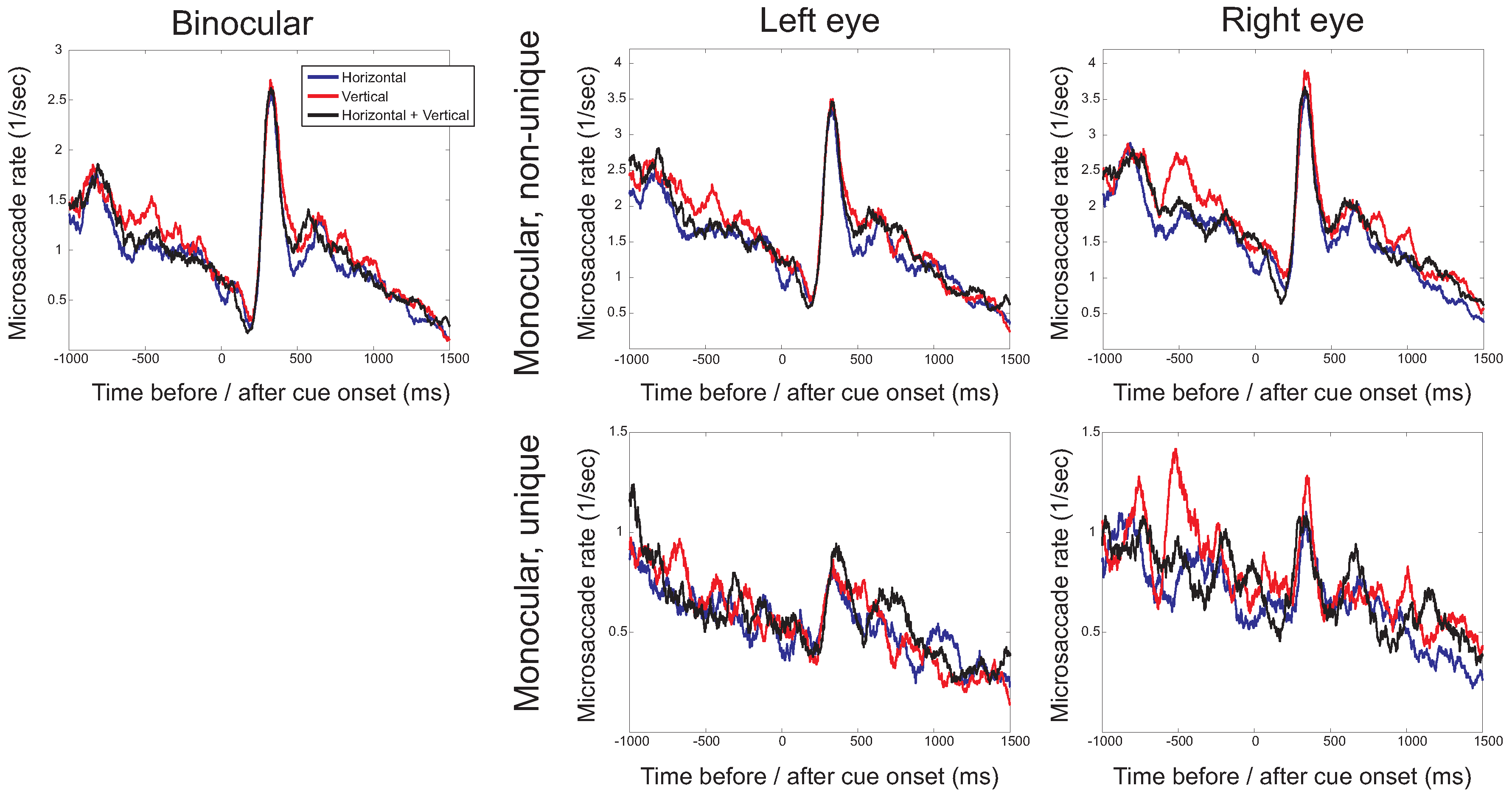
Copyright © 2010. This article is licensed under a Creative Commons Attribution 4.0 International License.
Share and Cite
Hermens, F.; Walker, R. What Determines the Direction of Microsaccades? J. Eye Mov. Res. 2009, 3, 1-20. https://doi.org/10.16910/jemr.3.4.1
Hermens F, Walker R. What Determines the Direction of Microsaccades? Journal of Eye Movement Research. 2009; 3(4):1-20. https://doi.org/10.16910/jemr.3.4.1
Chicago/Turabian StyleHermens, Frouke, and Robin Walker. 2009. "What Determines the Direction of Microsaccades?" Journal of Eye Movement Research 3, no. 4: 1-20. https://doi.org/10.16910/jemr.3.4.1
APA StyleHermens, F., & Walker, R. (2009). What Determines the Direction of Microsaccades? Journal of Eye Movement Research, 3(4), 1-20. https://doi.org/10.16910/jemr.3.4.1



